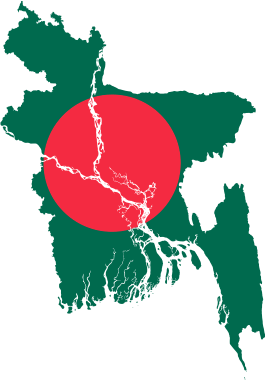Bikrampur
Bikrampur ("City of Courage") was a pargana situated 19 kilometres (12 mi) south of Dhaka, the modern capital city of Bangladesh. In the present day it is known as Munshiganj District of Bangladesh. It is a historic region in Bengal. It was a part of the Bhawal Estate.
Part of a series on the |
|---|
| History of Bangladesh |
 |
|
|
Ancient
|
|
Classical
|
|
Medieval
|
|
Modern
|
|
|
Related articles |
|
|
History
Early history
Ashoka, the emperor of the Maurya Dynasty, ruled all of major parts of Bengal from ca. 269 BC to 232 BC.[1] Being a devotee of Gautama Buddha, he propagated Buddhism across his kingdom which included Bikrampur to the east. Following the high ideals of this religion, Pala Kings came to Bikrampur to rule the region.[2]
Pala Era
The second ruler of Pala Empire, Dharmapal, built a Buddhist monastery in Bikrampur during his reign in 770–810.[3] After his death, his son, Devapala ruled this area until 850 CE. Then the region is successively ruled by Vigrahapala I, Narayanapala, Rajyapala, Gopala II, Vigrahapala II, Mahipala, Naya Pala, Vigrahapala III, Mahipala II, Shurapala II, Ramapala, Kumarapala, Gopala III and Madanapala.[4] Pala empire disintegrated in 1174 weakened by attacks of the Sena dynasty.[5]
Chandra Era
During the rule of Srichandra (reigned 930 – 975 AD), the administrative centre of the Chandra kingdom was established at Bikrampur.[6]
Sen Era
A copper-plate inscription from the time of the ruler Vijay Sen (ruled 1097–1160), founder of Sen dynasty, was found in Barrackpore, in 1911. In this inscription, Bikrampur was mentioned as the capital of that region.[7] It continued to be the capital throughout the, Sena Dynasty. In 1205, Turkic invader Bakhtiyar Khalji defeated the then-ruler Lakshman Sen in Nadia. Lakshman fled to Bikrampur.[8] His two sons Vishwarup Sen and Keshab Sen kept ruling from here until 1230.[9] But the copper-plate inscriptions during their reign do not mention Bikrampur as the capital.[10] Another Hindu ruler, Danuj Rai, defeated a successor of Keshab Sen and started ruling from here. In early 1280 he moved the capital to Suvarnagrama (later named Sonargaon).[10][11]
Mughal Era
Emperor Akbar established Bikrampur as one of the 52 parganas of Sonargaon sarkar in Bengal subah during his administrative reforms in 1572–1580.[12] During his time, Chand Rai[13] and Kedar Rai[14] were the Zamindars of Bikramapur. In the expeditions against Bara-Bhuiyans, Mughal Subahdar Man Singh killed Kedar Rai in early 1600s.[15]
In post-Aurangzeb era, during the time of Nawab Murshid Quli Khan, Bikrampur was divided into eight taluks – Bhagyakul, Sreenagar, Maijpara, Sinhapara, Taltala, Sirajdikhan, Louhojong and Baligaon. Each taluk was represented by one Zamindar. Muhammad Azim Khan became the Zamindar of Louhajong who held the title of "Khan Bahadur". Gobinda Prasad Roy became the Zamindar of Maijpara.[16]
Prominent people from Bikrampur
- Atiśa or srigayan Atis Dipankar (980–1054)
- Atul Chandra Kar ( freedom fighter , born in 1914 & died in 1993 in india - falakata ,W.B)
- Raja Rajvallabh Sen (died 1763)
- Durga Mohan Das (1841–1897)
- Dwarkanath Ganguly (1844–1898)
- Jagadish Chandra Bose (1858–1937)
- Chittaranjan Das (1870–1925)
- Sarojini Naidu (1879–1949)
- Suhasini Ganguly (1909–1965)
- Narayan Debnath (born 1925)
- Jogendranath Gupta (1883—1965)
- Sarada Ukil (1888–1940)
- Prasanta Chandra Mahalanobis (1893–1972)
- Benoy Basu (1908–1930)
- Dinesh Gupta (1911–1931)
- Badal Gupta (1912–1930)
- Samaresh Basu (1924–1988)
- Brojen Das (1927–1998)
- Iajuddin Ahmed (1931–2012)
- Shirshendu Mukhopadhyay (born 1935)
- M. Hamidullah Khan (1938–2011)
- Fakhruddin Ahmed (born 1940)
- Chashi Nazrul Islam (1941–2015)
- Humayun Azad (1947–2004)
- Imdadul Haq Milan (born 1955)
- Nripen Chakraborty(1905–2004)
- A. K. A. Firoze Noon (1946–2006)
- Bhanu Bandopadhyay (1920–1983)
- Radhu Karmakar (1919–1993)
See also
- Munshiganj Vihara
References
- Thapur (1973), p. 51.
- Bradley, F.B. (1906). The Romance of an Eastern Capital. Smith, Elder & CO. pp. 26.
- Ray, Krishnendu (2012). "Vikramashila Mahavihara". In Islam, Sirajul; Jamal, Ahmed A. (eds.). Banglapedia: National Encyclopedia of Bangladesh (Second ed.). Asiatic Society of Bangladesh.
- Chowdhury, AM (2012). "Pala Dynasty". In Islam, Sirajul; Jamal, Ahmed A. (eds.). Banglapedia: National Encyclopedia of Bangladesh (Second ed.). Asiatic Society of Bangladesh.
- Scott, David (May 1995). "Buddhism and Islam: Past to Present Encounters and Interfaith Lessons". Numen. 42 (2): 141–155. doi:10.1163/1568527952598657. JSTOR 3270172.
- Chowdhury, AM (2012). "Chandra Dynasty, The". In Islam, Sirajul; Jamal, Ahmed A. (eds.). Banglapedia: National Encyclopedia of Bangladesh (Second ed.). Asiatic Society of Bangladesh.
- Proof of Bikrampur as the ancient capital of Bengal Archived 14 July 2011 at the Wayback Machine, Golam Ashraf Khan Uzzal
- Misra, Chitta Ranjan (2012). "Laksmanasena". In Islam, Sirajul; Jamal, Ahmed A. (eds.). Banglapedia: National Encyclopedia of Bangladesh (Second ed.). Asiatic Society of Bangladesh.
- "Far East King Lists". Retrieved 30 December 2013.
- Chowdhury, AM (2012). "Vikramapura". In Islam, Sirajul; Jamal, Ahmed A. (eds.). Banglapedia: National Encyclopedia of Bangladesh (Second ed.). Asiatic Society of Bangladesh.
- Taher, MA (2012). "Raja Ganesha". In Islam, Sirajul; Jamal, Ahmed A. (eds.). Banglapedia: National Encyclopedia of Bangladesh (Second ed.). Asiatic Society of Bangladesh.
- Abul Fazl-I-'Allami (1949, reprint 1993). Ain-I-Akbari, Vol.II (tr. H.S. Jarett), Calcutta: The Asiatic Society, p.151
- Khan, Muazzam Hussain (2012). "Chand Rai". In Islam, Sirajul; Jamal, Ahmed A. (eds.). Banglapedia: National Encyclopedia of Bangladesh (Second ed.). Asiatic Society of Bangladesh.
- Khan, Muazzam Hussain (2012). "Kedar Rai". In Islam, Sirajul; Jamal, Ahmed A. (eds.). Banglapedia: National Encyclopedia of Bangladesh (Second ed.). Asiatic Society of Bangladesh.
- "Bangladesh". google.com. Retrieved 29 September 2015.
- ":: Munshigonj District – Heritage Places – Maijpara Math ::". munshigonj.com. Archived from the original on 30 September 2015. Retrieved 29 September 2015.